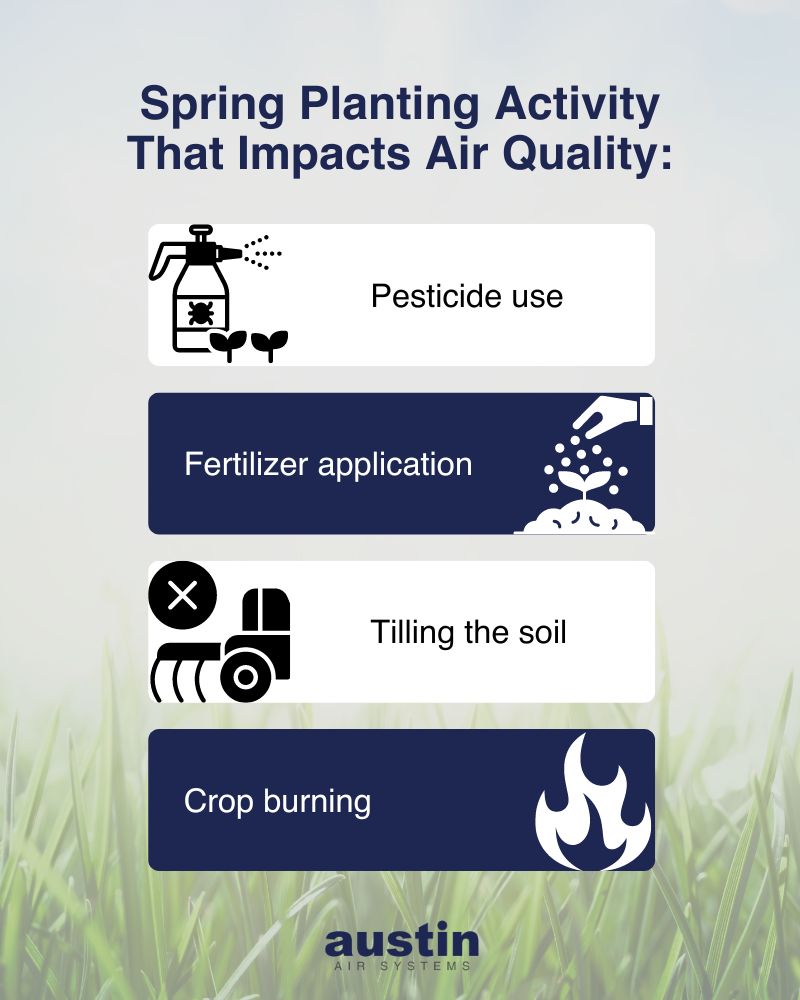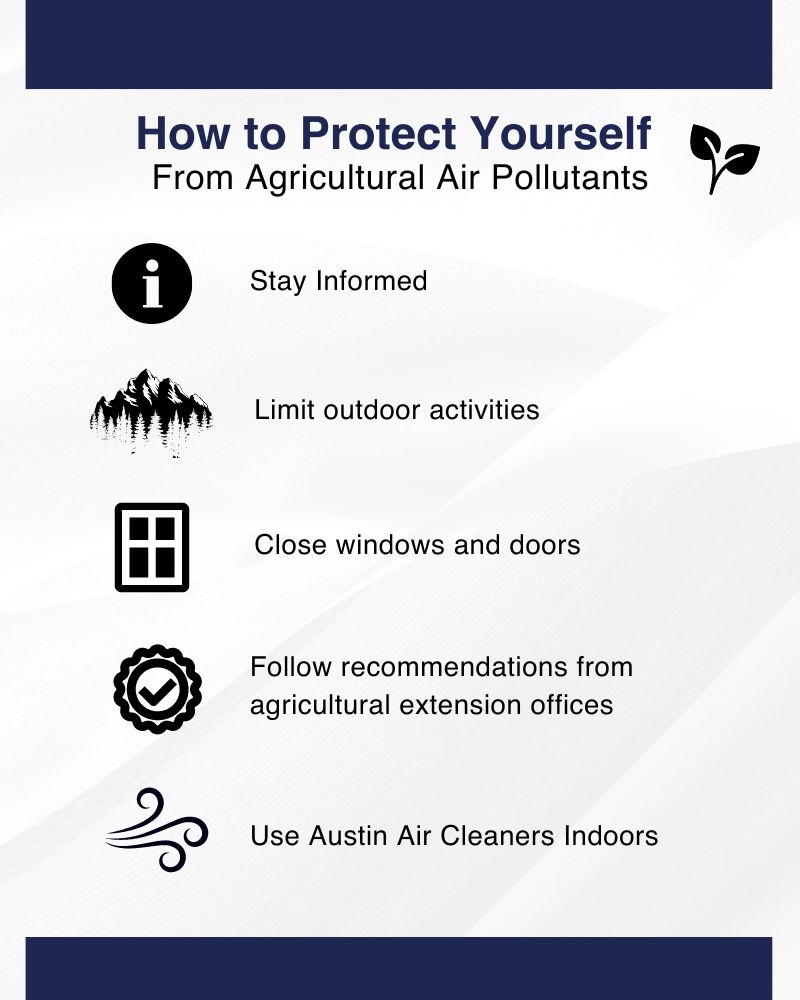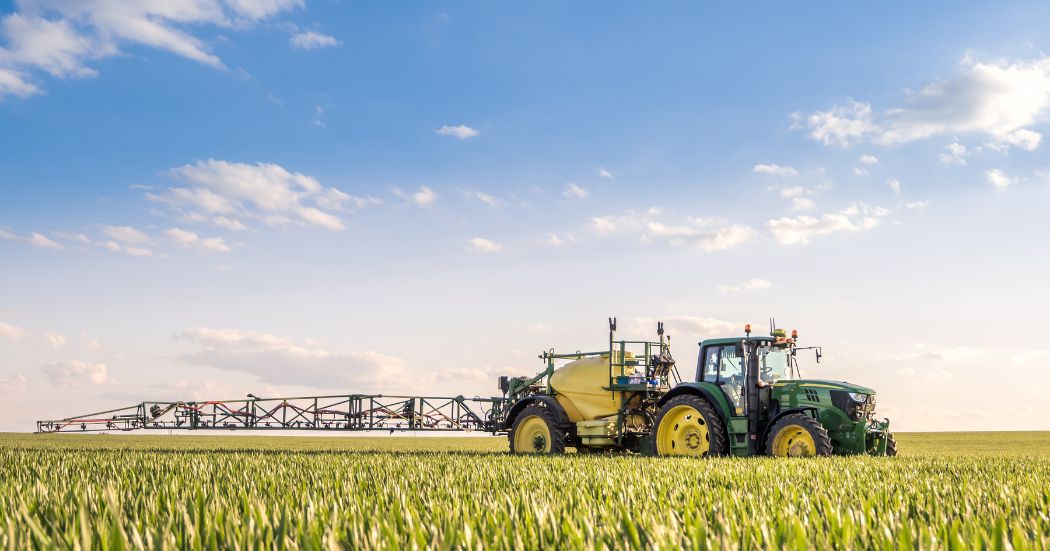As spring approaches, rural landscapes that lay dormant through the winter begin to bustle with the activity of planting season. Unfortunately, amidst the hopes for abundant harvests, there is an overlooked concern that looms over these rural communities: air quality.
When you think of air pollution, you probably imagine urban areas with a lot of traffic and proximity to heavy industry. But rural regions with agricultural activity also have air quality concerns from farming practices.
The truth is, activities which are essential for feeding growing populations like tilling the soil and applying fertilizers and pesticides also pose significant challenges to the health of farmers and nearby rural communities.1
Dangers Lurking in the Country Air
For many years, air pollution was measured solely by the mass (amount) of fine particulate matter (PM2.5) but a recent study from the University of Illinois demonstrates that the toxicity of the air is also a leading concern.2
Looking beyond the measure of PM2.5 in the air, they examined the cellular oxidative potential of airborne particles. Cellular oxidative potential (OP) is a particle’s ability to produce reactive, oxygen-based chemicals, which can create a range of negative impacts within lung tissue cells.
The researchers learned that although there is generally a lower amount of PM2.5 in rural areas, the samples from urban and rural areas had similar levels of OP. They also found that the OP from rural particles was higher during spring and summer, signifying that higher agricultural activity during planting season can result in PM2.5 which is just as toxic as urban air – and sometimes even more so.
This science is groundbreaking, and OP is being considered as a new way to measure the toxicity of PM2.5.3
Airborne Pollutants in Farming Communities
During the early spring planting season in rural areas, several air quality concerns can arise due to agricultural activities, even miles from the source. These concerns include some of the most common farming practices.
Pesticides
Pesticide application during planting season can result in the release of volatile organic compounds (VOCs) into the air. These compounds can react with other pollutants in the atmosphere to form ground-level ozone, a major component of smog, which can impair lung function and exacerbate respiratory conditions like asthma and COPD.
Pollutants sometimes linger low to the ground instead of dispersing into the atmosphere due to temperature inversion, where a hot layer of air higher in the atmosphere tops colder air at the surface and causes the air low to the ground to remain stagnant. Temperature inversion is more common in winter months and can linger into the early spring months, when weather is still cool.
If pesticides are sprayed during an inversion, tiny droplets have the potential to travel long distances, spanning thousands of feet, before eventually reaching the ground. Additionally, certain pesticides have the capability to volatilize, transitioning from liquid to vapor form. These vaporized pesticides can disperse for miles away from the point of application, particularly in the presence of a temperature inversion.4
Pesticides are particularly worrisome as exposure to pesticides in any form can be detrimental to the neurological development of children.5 Additionally, seniors struggle to process pesticide exposure because their kidneys and livers are less able to filter the toxins.6
Fertilizers
The application of nitrogen-based fertilizers, which is common during planting season, can lead to the release of ammonia into the atmosphere. This additional ammonia contributes to both the formation of PM2.5 and the toxicity of it. It can also lead to the formation of secondary pollutants, such as ammonium nitrate and ammonium sulfate.
Tilling the Soil
Tillage operations, such as plowing and disking, can generate significant amounts of PM2.5, especially in dry soil conditions. These fine particles can be suspended in the air, leading to decreased air quality.
Dust and particulate matter generated from tilling the soil can also settle on nearby surfaces, including roads, buildings, and water bodies, and also get indoors.
Prescribed Burns
Also known as controlled burns, prescribed burns are planned fires that help to clear up crop residue and promote new growth of certain plant species. They are also a standard land management practice in forested areas, by clearing up materials that would otherwise be a risk for a larger wildfire if not burned proactively.
Springtime is a popular time for prescribed burns in many regions, because of the cooler weather. Spring is also a preferred time for controlled burns anywhere vegetation is still recovering from the dormancy of winter to control invasive vegetation. Although these fires are crucial for land management, they still contribute to the amount of PM2.5 and other pollutants into the air.
Overall, planting season presents challenges in terms of maintaining air quality and unfortunately, all these farming-related outdoor air contaminants inevitably make it into our indoor environments.

Protect Yourself From Agricultural Air Pollutants
How can you stay safe if you live in a rural area – especially when pollutants can travel far from where they originate? Although avoiding agricultural air pollutants can be challenging, several strategies can help minimize your exposure. Here are some suggestions:
- Stay Informed: Stay updated on local air quality forecasts and agricultural activities in your area. Many environmental agencies provide air quality alerts and advisories, especially during peak planting seasons.
- Limit Outdoor Activities: If air quality is poor due to nearby agricultural activities, consider limiting outdoor activities, especially strenuous exercises, during peak pollution periods. When planning outdoor activities, try to choose days with lower pollution levels, such as days with favorable weather conditions and reduced agricultural activities.
- Close Windows and Doors: Keep windows and doors closed during pesticide applications or when dust levels are high to prevent pollutants from entering indoor spaces.
- Follow Safety Guidelines: If you work in agriculture or live near farmland, follow safety guidelines and recommendations provided by agricultural extension offices or regulatory agencies to minimize exposure to pesticides and other pollutants.
- Use Air Purifiers: Consider using air purifiers with HEPA filters and activated carbon to remove airborne pollutants and improve indoor air quality. Austin Air builds the only clinically-proven air purifiers on the market.
By taking these steps, individuals can help minimize exposure to air pollutants common during planting season and times of high agricultural pollution (i.e. whenever pesticides are being applied).
Stay safe everyone and if you get a chance, thank a farmer for everything that they do to keep us fed, while also risking their own health.

CITATIONS
1 Liu J, Schelar E. Pesticide Exposure and Child Neurodevelopment: Summary and Implications. Workplace Health & Safety. 2012;60(5):235-242. doi: 10.1177/216507991206000507.
2 Wang Y, Puthussery JV, Yu H, et al. Sources of cellular oxidative potential of water-soluble fine ambient particulate matter in the Midwestern United States. J Hazard Mater. 2022 Mar 5;425:127777. doi: 10.1016/j.jhazmat.2021.127777.
3 Yadav, S., & Phuleria, H. C. (2019, October 9). Oxidative Potential of Particulate Matter: A Prospective Measure to Assess PM Toxicity. Energy, Environment, and Sustainability. doi: 10.1007/978-981-15-0540-9_16.
4 Air Temperature Inversions Causes, Characteristics and Potential Effects on Pesticide Spray Drift. (2023, December 15). North Dakota State University Agriculture. https://www.ndsu.edu/agriculture/extension/publications/air-temperature-inversions-causes-characteristics-and-potential-effects.
5 Liu J, Schelar E. Pesticide exposure and child neurodevelopment: summary and implications. Workplace Health Saf. 2012 May;60(5):235-42; quiz 243. doi: 10.1177/216507991206000507.
6 Ginsberg, G.; Hattis, D.; Russ, A.; Sonawane, B. Pharmacokinetic and pharmacodynamic factors that can affect sensitivity to neurotoxic sequelae in elderly individuals. Environ. Health Perspect. 2005, 113 (9), 1243-1249. doi: 10.1289/ehp.7568.
